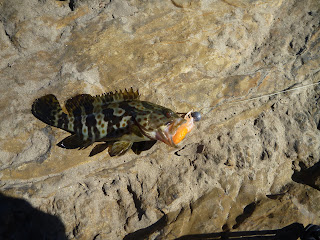Estuaries can be a productive fish community, with numerous targetable species from flathead to barramundi. While many estuaries can’t easily be fished without a boat, or kayak, low tide can be a peak time for land based anglers.
 While on a treck through my local estuary system, at lowtide, with my fishing companion Daniel, we aimed to spend the day throwing soft-plastics at the snags and over the sand flats. The tackle I was using was my Okuma graphite spin Travel rod with my Okuma Flame 30, which was spooled with Sufix Duraflex line. Spin combos are the best light gear for this type of fishing.
While on a treck through my local estuary system, at lowtide, with my fishing companion Daniel, we aimed to spend the day throwing soft-plastics at the snags and over the sand flats. The tackle I was using was my Okuma graphite spin Travel rod with my Okuma Flame 30, which was spooled with Sufix Duraflex line. Spin combos are the best light gear for this type of fishing.We started 2 hours before the peak of low tide and walked our way through a system of shallow creeks. My lure of choice was the Storm Wildeye Twitching Nipper, which produce most bites in the pearl colour. The main technique with these soft plastics is to cast them into the snags, let them sink to the bottom, then give them a few sharp twitches, before repeating this process. The key to this technique is to watch your line. Most fish strike on the pause or when the lure falls, so if you see any slight tap on the line as the lure sinks, strike to hook up the fish.
While using this method in the upper reaches of the creek, we hooked up on a few nice flathead, which were sitting in the sandy patches, waiting for an unsuspecting baitfish or yabby to wonder by. The flathead ranged from lengths of 30cm, through to the tougher 55cm specimens that lurked over the sandy creek floor.
The snags were only about 5m away from our feet in some areas, which made casting a breeze, though the tannin coloured water minimised any vision of the fish.
As well as flathead, we regularly hooked up on goldspot rockcod, which were more commonly found in the mangrove roots and timber structure. These fish seemed to vary in colour and patterns throughout the species. I caught these two goldspot rockcod off the same snag and they displayed two very separate colourations.
While Dan and I walked across a sand flat covered in potholes, Daniel offered to show me a magic trick. He handed me his rod, bent down and pulled a large male mud crab out of a pothole. We tied it up and threw it in my backpack.
At the last creek, we had been casting for a while without much success. The creek was a bit wider than the others, so it was a bit harder to get the lure closer to the snags. I waded out as much as I could, and casted the lure, which landed just off the roots of a big mangrove snag. I gave the lure a quick twitch as soon as it hit the water and waited for it to sink. The lure didn’t sink though, so I whipped my rod back and felt quite a weight on the other end of my line. The fish crisscrossed through the water and pulled heaps of line of my Okuma Flame 30 reel. The fish turned out to be a Queenie, put up a hell of a fight and didn’t surrender one bit. Even though it was landed and in my hands it kept flopping about. This proves that the Storm Twitching Nippers can really catch any estuary species. The Queenfish was released after a couple quick pictures and we started to head back before the tide came in.

We casted along the snags in a few of the last creeks for a while, where we hooked up on more flathead, rockcod and even a few barramundi.
 Daniel hooked a 30cm cod, and while bringing it in, a huge dusky flathead smashed it in the shallows and tried to engulf it. All the fish were tagged and released, but I can’t wait to get out there again and hopefully catch that monster flathead.
Daniel hooked a 30cm cod, and while bringing it in, a huge dusky flathead smashed it in the shallows and tried to engulf it. All the fish were tagged and released, but I can’t wait to get out there again and hopefully catch that monster flathead.














































